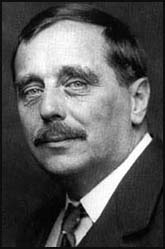On this date in 1866, (Herbert George) H.G. Wells was born to a working-class family in Kent, England. He received a spotty education, interrupted by several illnesses and family difficulties, and became a draper’s apprentice as a teen. Wells earned a government scholarship in 1884 to study biology under Thomas Henry Huxley at the Normal School of Science. Wells earned his bachelor of science and doctor of science degrees at the University of London.
After marrying his cousin Isabel, Wells began to supplement his teaching salary with short stories and freelance articles, then books, including The Time Machine (1895), The Island of Dr. Moreau (1896), The Invisible Man (1897) and The War of the Worlds (1898). Wells created a mild scandal when he divorced Isabel to marry one of his best students, Amy Catherine Robbins. Although his second marriage was lasting and produced two sons, Wells was an unabashed advocate of free (as opposed to “indiscriminate”) love. He continued to openly have extramarital liaisons, most famously with Margaret Sanger, and a 10-year relationship with the author Rebecca West, who had one of his two out-of-wedlock children.
As a member of the socialist Fabian Society, Wells sought active change. His 100 books included nonfiction such as A Modern Utopia (1905), The Outline of History (1920), A Short History of the World (1922), The Shape of Things to Come (1933) and The Work, Wealth and Happiness of Mankind (1932). One of his booklets was Crux Ansata, An Indictment of the Roman Catholic Church. Although Wells toyed briefly with the idea of a “divine will” in his book God the Invisible King (1917), it was a temporary aberration.
Wells used his international fame to promote his favorite causes, including the prevention of war, and was received by government officials around the world. He is best remembered as an early writer of science fiction and futurism. D. 1946.

